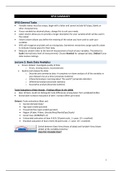Samenvatting
Summary Customer and Marketing Analytics - SPSS - Lecture Addition - 2019 - Vrije Universiteit
This document serves as an addition to the lecture summary of customer and marketing analytics from the academic year 2019/2020. It includes a detailed summary of the steps discussed in class for the program SPSS. The document is especially helpful for students not too familiar with SPSS. Grade ach...
[Meer zien]




